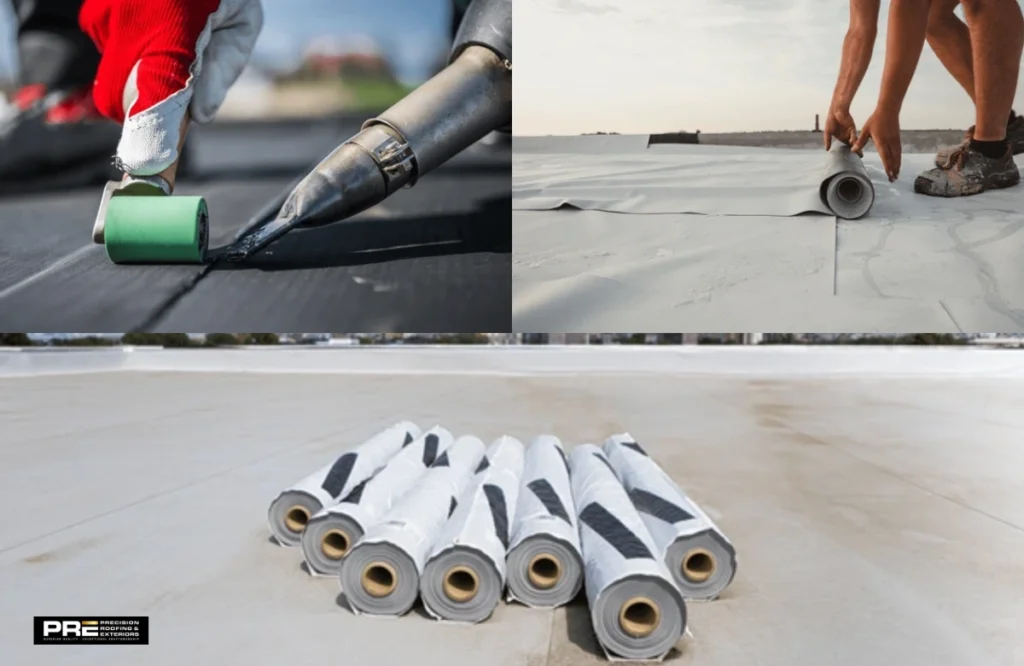Rubber roofing is a popular and reliable choice for many buildings, particularly those with flat or low-slope roofs. Known for its durability, flexibility, and long lifespan, rubber roofing has become a reliable option for residential and commercial properties. It offers significant protection against the elements, is cost-effective, and can withstand harsh weather conditions. When choosing rubber roofing, it’s important to understand the different types available, as each offers unique benefits. The most common types of rubber roofing include EPDM (Ethylene Propylene Diene Monomer), TPO (Thermoplastic Olefin), PVC (Polyvinyl Chloride), and modified bitumen.
Most Common Types of Rubber Roofing
Here are the different types of rubber roofing:
1. EPDM Rubber Roofing
EPDM roofing is one of the most widely used types of rubber roofing. This type is made from a synthetic rubber compound, offering excellent weather resistance and UV stability. EPDM is popular for its affordability and ability to withstand harsh weather conditions, such as extreme heat, cold, and heavy rain. This roofing type is also known for its longevity, often lasting over 30 years with proper maintenance. EPDM rubber roofing installation is commonly performed by professionals due to its ease and long-term reliability.
- Durability: Resistant to ozone, UV rays, and extreme temperatures.
- Cost-Effective: One of the most affordable rubber roofing options.
- Maintenance: Easy to repair with simple tools.
EPDM roofing is available in both black and white versions, with black being the most common. The black EPDM roofing is ideal for colder climates, as it absorbs heat, whereas white EPDM reflects sunlight, making it suitable for hotter regions.
2. TPO Rubber Roofing
TPO is a relatively newer type of rubber roofing material than EPDM. It is made from a blend of polypropylene and ethylene-propylene rubber, providing a strong and energy-efficient roofing option. TPO is known for its reflective properties, which help reduce energy costs by reflecting sunlight. These properties make it an excellent choice for buildings in hot climates.
- Energy-Efficient: Reflective surface reduces cooling costs.
- Lightweight: Easier to install and handle.
- Eco-Friendly: Made from recyclable materials.
One of the standout features of TPO roofing installation is its ability to improve a building’s energy efficiency by lowering the need for air conditioning. Its reflective surface reduces the heat the roof absorbs, helping keep the building cooler during the summer months.
3. PVC Rubber Roofing
PVC (Polyvinyl Chloride) roofing is another high-quality rubber roofing material. Known for its exceptional durability and resistance to chemical damage, PVC roofing is often used in commercial buildings where durability and weather resistance are key. PVC is highly resistant to fire, punctures, and UV rays, making it one of the best options for roofs exposed to harsh environmental conditions.
- Fire-Resistant: Ideal for buildings that require extra fire protection.
- Durable: Resistant to chemicals, oils, and grease.
- Long Lifespan: Can last over 20 years with minimal maintenance.
PVC roofing comes in various colors, with white being the most common. Its reflective nature also helps reduce energy consumption, making it energy-efficient, like TPO roofing.
4. Modified Bitumen
Modified bitumen roofing is a combination of asphalt and rubber. Though it is not as common as EPDM, TPO, or PVC, modified bitumen provides another reliable option for flat roofing. It is applied in layers, making it a great choice for those who want a durable, waterproof, and heat-resistant roofing solution.
- Versatile Application: Heat, cold adhesive, or self-adhesive methods can be applied.
- Waterproof: Provides excellent protection against leaks.
- Durable: Offers a long-lasting roofing solution.
Modified bitumen roofing is popular in colder climates because it provides a sturdy, watertight seal. It is available in different finishes, such as smooth, granulated, or reflective, to suit various needs.
5. Rubber Slate Roofing
Rubber slate roofing is made from recycled rubber, often in the form of tiles or shingles. It mimics the appearance of traditional slate roofing, offering a stylish and durable alternative at a lower cost. This type of rubber roofing is ideal for homeowners who want the aesthetic of slate without the high price tag or heavy weight.
- Eco-Friendly: Made from recycled rubber, reducing environmental impact.
- Aesthetic Appeal: Mimics the look of traditional slate roofing.
- Lightweight: Easier to install compared to actual slate.
Rubber slate roofing is known for its strength and resistance to extreme weather conditions. It also has low maintenance and provides long-lasting protection from the elements.
Conclusion
Choosing the right type of rubber roofing depends on factors such as climate, budget, and the specific needs of your building. Whether you opt for EPDM, TPO, PVC, or modified bitumen, each type has benefits that make it suitable for different environments.
Rubber slate provides a more natural look, while TPO and PVC focus on energy efficiency. Ultimately, understanding the types of rubber roofing and their advantages will help you make the best choice for your home or business. Always consider the climate, roofing needs, and how long rubber roof last for the best results when choosing.
Need expert roofing services? Contact professional roofing contractor like Precision Roofing today to install the perfect rubber roof for your property!

